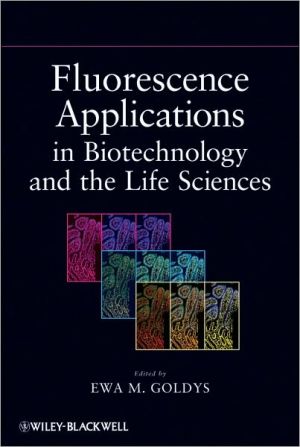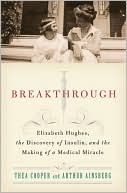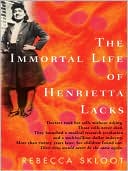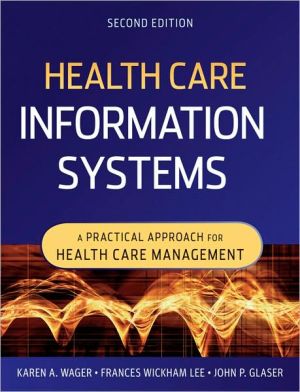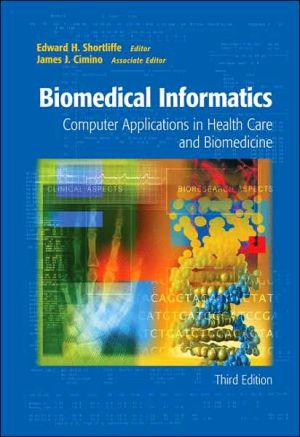Fluorescence Applications in Biotechnology and Life Sciences
A self-contained treatment of the latest fluorescence applications in biotechnology and the life sciences\ This book focuses specifically on the present applications of fluorescence in molecular and cellular dynamics, biological/medical imaging, proteomics, genomics, and flow cytometry. It raises awareness of the latest scientific approaches and technologies that may help resolve problems relevant for the industry and the community in areas such as public health, food safety, and...
Search in google:
Fluorescence Applications in Biotechnology and the Life SciencesEdited byEwa M. GoldysA self-contained treatment of the latest fluorescence applications in biotechnology and the life sciencesFluorescence Applications in Biotechnology and the Life Sciences is the first reference in this important subject area to focus specifically on the present applications of fluorescence in molecular and cellular dynamics, biological/medical imaging, proteomics, genomics, and flow cytometry. It is designed to raise awareness of the latest scientific approaches and technologies that may help resolve problems relevant for the industry and the community in areas such as public health, food safety, and environ-mental monitoring.Following an introductory chapter on the basics of fluorescence, the book covers: labeling of cells with fluorescent dyes; genetically encoded fluorescent proteins; nanoparticle fluorescence probes; quantitative analysis of fluorescent images; spectral imaging and unmixing; correlation of light with electron microscopy; fluorescence resonance energy transfer and applications; monitoring molecular dynamics in live cells using fluorescence photo-bleaching; time-resolved fluorescence in microscopy; fluorescence correlation spectroscopy; flow cytometry; fluorescence in diagnostic imaging; fluorescence in clinical diagnoses; immunochemical detection of analytes by using fluorescence; membrane organization; and probing the kinetics of ion pumps via voltage-sensitive fluorescent dyes.With its multidisciplinary approach and excellent balance of research and diagnostic topics, this book will appeal to postgraduate students and a broad range of scientists and researchers in biology, physics, chemistry, biotechnology, bioengineering, and medicine.
Preface xvAcknowledgments xxiAbout the Contributing Authors xxiii1 Basics of Fluorescence Robert P. Learmonth Scott H. Kable Kenneth P. Ghiggino 11.1 Introduction 11.1.1 Properties of Light 21.1.2 States of Molecules 51.2 Absorption and Emission of Light 91.2.1 Interaction of Light with a Molecule 91.2.2 Absorption and Emission of Light Depicted on a Perrin-Jablonski Diagram 101.2.3 Multiphoton Excitation 111.3 Noradiative Decay Mechanisms 131.3.1 Vibrational Relaxation 131.3.2 Internal Conversion 141.3.3 Intersystem Crossing 141.4 Properties of Excited Molecules 161.4.1 Quantum Yield 161.4.2 Excited-State Lifetime 161.5 Spectroscopy and Fluorophores 161.5.1 Absorption, Excitation, and Emission Spectra 161.5.2 Basic Properties of Fluorophores 191.6 Environmental Sensitivity of Fluorophores 201.6.1 Quenching of Fluorescence 211.6.2 Photobleaching 211.6.3 Fluorescence Resonance Energy Transfer 221.6.4 Solvent Relaxation 221.7 Polarization of Fluorescence 241.8 Conclusion 26References 262 Labeling of Cells with Fluorescent Dyes Ian S. Harper 272.1 Introduction 272.2 Fluorophores Selection 322.3 Loading and Labeling Live Cells 342.3.1 Loading AM Forms 352.3.2 Leakage and Hydrolysis of AM Esters 362.4 Fluorophores for Live Cell Imaging 362.4.1 Cell Viability 362.4.2 General Morphology 362.4.3 Specific Organelles 372.4.4 Ionic Environment 382.4.5 Tracers for Membranes and Cells 392.4.6 Fluorescent Proteins 40References 413 Genetically Encoded Fluorescent Probes: Some Properties and Applications in Life Sciences Mark Prescott Anya Salih 473.1 Introduction473.2 Chromophore and its Formation 493.3 "Life and Death" of Fluorescent Protein 543.3.1 Oligomerization 573.3.2 Fusion Proteins 583.3.3 Photobleaching 583.3.4 Destabilization 593.4 Applications 603.5 Passive Applications 613.5.1 Photoamplifying PAFPs 623.5.2 Photoconverting PAFPs 633.5.3 Kindling PAFPs 643.5.4 Fluorescent Timers 643.6 Active Applications 653.6.1 Protein-Protein Interactions 653.6.2 Monitoring Enzyme Activity 663.6.3 Monitoring Small Molecules and Metabolites 663.6.4 Monitoring pH and Other Small Molecules 673.6.5 Monitoring Redox 673.7 Interactive Applications 673.8 Conclusions 68References 694 Nanoparticle Fluorescence Probes Krystyna Drozdowicz-Tomsia Ewa M. Goldys 754.1 Introduction 754.2 Nanomaterials for Biological Applications 754.3 Inorganic Quantum Dots: Physics and Optical Properties 774.4 Synthesis of Monodisperse Colloidal Quantum Dots for Biolabeling Applications 814.4.1 Quantum Dot Synthesis 824.4.2 Shell Synthesis 844.4.3 Water Solubilization and Functionalization 854.4.4 Quantum Dot Bioconjugation 884.5 Quantum Dots as In Vitro Probes 894.6 Quantum Dots as In Vivo Probes 924.7 Cytotoxicity 944.8 Future Directions 94References 955 Quantitative Analysis of Fluorescent Image: From Descriptive to Computational Microscopy Michal Marek Godlewaski Agnieszka Turowska Paulina Jedynak Daniel Martinez Puig Helena Nevalainen 995.1 Introduction 995.2 Advantages of Quantitative Analysis 1005.3 Methods of Quantitative Analysis 1015.4 Image Processing 113References 1156 Spectral Imaging and Unmixing Pascal Vallotton Aloke Phatak Mark Berman 1176.1 Introduction 1176.2 Instrumentation and Configurations for Hyperspectral Microscopes 1196.3 Supervised and Unsupervised Unmixing 1216.4 Supervised or Informed Unmixing 1216.5 Unsupervised or Blind Unmixing 1226.5.1 Iterated Constrained End-Members Algorithm 1236.6 Spectral Clustering 1246.7 Examples 1256.7.1 Tablet Inspection 1256.7.2 Fluorescent Microspheres 1276.7.3 Induced Mouse Lung Tumor 1316.8 Limitations of Spectral Imaging and Experimental Considerations 1356.8.1 Fast Biological Processes 1356.8.2 Calibration 1366.8.3 Environmental Sensitivity 1376.8.4 Background Fluorescence 1376.9 Conclusions 137References 1387 Correlation of Light with Electron Microscopy: A Correlative Microscopy Platform Marko Nykäet;nen 1417.1 Introduction 1417.2 Overview of Techniques Used in Correlative Microscopy 1427.3 Correlative Microscopy of Chemically Fixed, Immunolabeled Ultrathin Cryosections Employing Antibodies Coupled with Fluorescent Gold Conjugates 1457.4 Special Techniques Used in Sample Preparation for Correlative Microscopy: High-Pressure Freezing, Freeze Fracturing, and Freeze Substitution 1517.5 Correlative Microscopy of Fixed Tissue Specimens Using Freeze Substitution 1537.6 Future Trends: Correlative Microscopy and High-Content Cellular Screening 1547.7 Future Trends: Correlative Microscopy of Fluorescent Images Acquired by Confocal Laser Scanning Microscopy 154References 1558 Fluorescence Resonance Energy Transfer and Applications Andrew Clayton 1578.1 What is FRET? 1578.1.1 Theory of FRET 1578.2 Why FRET Can Be Useful 1598.3 How FRET Can Be Measured 1608.3.1 Applications of FRET in Spectroscopy 1618.3. Applications of FRET in Microscopy 1648.4 Emerging Applications Including Novel FRET Probes 1698.4.1 Intramolecular FRET 1698.4.2 Intermolecular FRET 1718.5 Advanced FRET Methods 171References 1729 Monitoring Molecular Dynamics in Live Cells Using Fluorescence Photobleaching Nectarios Klonis Leann Tilley 1759.1 Introduction 1759.2 Photobleaching Theory 1769.3 Dynamics of Macromolecules 1779.3.1 Macromolecular Mobilities 1779.3.2 Fluorescence Recovery After Photobleaching 1799.4 Photobleaching Measurements with Confocal Microscope 1839.5 Photobleaching Applications 1879.5.1 Macromolecular Organization 1879.5.2 Monitoring Movement between Different Compartments 1909.5.3 Fluorescence Loss in Photobleaching 1919.5.4 Fluorescence Resonance Energy Transfer 1929.6 Conclusions 194References 19410 Time-Resolved Fluorescence in Microscopy Trevor A. Smith Craig N. Lincoln Damian K. Bird 19510.1 Introduction 19510.2 Photophysics and Deactivation of Excited State 19510.3 Time-Resolved Fluorescence Measurements 19710.3.1 Deviations from Ideal Decay Behavior 19810.3.2 Time-Resolved Fluorescence Techniques 20010.4 Time-Resolved Fluorescence in Microscopy 20610.4.1 Factors That Influence Choice of TRFM Method 21310.5 Conclusions 218References 21811 Fluorescence Correlation Spectroscopy Thomas Dertinger Iris von der Hocht Anastasia Loman Ingo Gregor Jöet;rg Enderlein 22311.1 Introduction 22311.2 Optics of Fluorescence Correlation Spectroscopy 22711.3 Practical Aspects of FCS Experiments 22911.4 Quantitative Evaluation of FCS Measurements to Obtain Diffusion Constants and Concentration 23011.4.1 One-Focus FCS 23011.4.2 Two-Focus FCS 23711.5 Conclusion 243References 24312 Flow Cytometry Russell E. Connally Graham Vesey Charlotte Morgan 24512.1 What is Flow Cytometry? 24512.1.1 History of Flow Cytometry 24612.1.2 Flow Cytometry Fundamentals 24812.1.3 Sensitivity of Flow Cytometers 25112.2 Excitation Sources 25212.2.1 Laser Excitation 25212.2.2 Gas Laser Sources 25312.2.3 Diode Lasers 25412.2.4 Solid-State Lasers 25412.3 Signal Detection and Analysis 25512.3.1 Forward Scatter 25512.3.2 Side Scatter 25512.3.3 Fluorescence 25512.3.4 Issues in Flow Cytometry Using Fluorescence: Fluorescence Compensation 25612.3.5 Multiparameter Analysis 25812.4 Cell Sorting 25812.5 Applications of Flow Cytometry 26012.5.1 Calibration 26012.5.2 Use of Beads for Diagnostic Purposes 26112.5.3 Water Testing 26212.5.4 Milk Analysis 26212.5.5 Brewing and Wine Production 26312.5.6 Food Microbiology 26412.5.7 Quality Control in Microbiological Testing in Various Industries 26412.5.8 Cytometry: Where to Now? 265References 26613 Fluorescence in Diagnostic Imaging Morry Silberstein 26913.1 Introduction 26913.2 Principles of Fluorescence Applied to Medical Diagnosis 26913.2.1 Contrast Agents 26913.2.2 Delivery Issues 27313.2.3 Amplification Strategies 27313.2.4 Introduction to Imaging Techniques In Vivo 27513.3 Optical Fluorescence Imaging Techniques In Vivo 27513.3.1 Near-Infrared Fluorescence Imaging 27513.3.2 Fluorescence Reflective Imaging 27513.3.3 Fluorescence Molecular Tomography 27713.3.4 Superficial Confocal Imaging (Optical Coherence Tomography) 27813.3.5 Other Techniques 28013.4 Imaging of Whole-Body Biological Systems 28013.4.1 Superficial Tumors 28013.4.2 Subsurface Tumors and Vascularity 28113.4.3 Lymphoreticular System 28213.4.4 Bone 28313.4.5 Brain 28313.5 Future Directions 283References 28614 Fluorescence in Clinical Diagnosis Wouter Kalle Phillip Bwititi Todd Walker 28914.1 Introduction 28914.2 Applications of Fluorescence in Clinical Biochemistry 28914.2.1 Advantages of Fluorescence Measurements 28914.2.2 Categories of Fluorescence Measurements 29014.2.3 Applications 29114.3 Fluorescence in Pathology and Cancer Diagnostics 29714.3.1 Fluorescent in Situ Hybridization 29714.3.2 Applications of Fluorescence in Clinical Cytology 301References 30415 Immunochemical Detection of Analytes by Using Fluorescence Evgenia G. Matveeva Ignacy Gryczynski Zygmunt Gryczynski Ewa M. Goldys 30915.1 Introduction: Definition and General Principles of Immunoassay 30915.2 Immunoassay Types and Formats 31115.2.1 Competitive and Sandwich Immunoassays 31115.2.2 Homogeneous and Heterogeneous (Solid-Phase) Immunoassays 31115.2.3 Types of Labels Used in Immunoassays with Fluorescence Detection (Fluorophores, Enzymes with Fluorogenic Substrates) 31315.3 Types of Analytes 31315.3.1 Cations, Metal Ions, and Anions 31315.3.2 Small-Molecule Analytes (Pesticides, Toxins, and Biomarkers) 31415.3.3 Proteins 31415.4 Steady-State Fluorescence Immunoassays 31415.4.1 Intensity-Based (Quenching, Enhancement) Assays: Environmentally Sensitive Probes 31415.4.2 Energy Transfer Assays 31515.4.3 Chemiluminescence Assays: Enzyme Immunoassays Utilizing Fluorescent Substrates 31515.4.4 Polarization Assays 31715.5 Time-Resolved and Kinetic Approaches as Tools for Elimination of Fluorescence Background 31815.5.1 Kinetic Approach, Stopped-Flow Immunoassays, Time-Gated Detection, and Lifetime Assays 31815.5.2 Near-Infrared Fluorophores 31915.6 Recent Advances in Immunoassay Signal Enhancement and Throughput 32015.6.1 Metal-Particle-Enhanced Immunoassays: Nanoparticles as Labels 32015.6.2 Surface Plasmon-Coupled Emission-Based Immunoassays 32115.6.3 Assay Miniaturization (Arrays, Microchips) 322References 32216 Membrane Organization Astrid Magenau, Carles Rentero, and Katharina Gaus 32716.1 Concepts of Organization of Biological Membranes 32716.1.1 Bilayer 32716.1.2 Conceptual Models of Membrane Organization 32816.2 Fluorescence Methods to Study Membrane Organization 33016.2.1 Fluorescence Intensity Imaging and Membrane Probes 33016.2.2 Fluorescence Recovery After Photobleaching 33216.2.3 Fluorescence Correlation Spectroscopy and Image Correlation Spectroscopy 33316.2.4 Fluorescence Resonance Energy Transfer and Fluorescence Lifetime Imaging Microscopy 33416.2.5 Total Internal Reflection Fluorescence Microscopy 33516.2.6 Single-Particle Tracking 33516.3 Model Membranes 33616.4 Membrane Organization in Cells 34016.4.1 Lipid Organization in Cell Membrane 34016.4.2 Protein-Lipid Interactions 34116.4.3 Protein-Protein Interactions 345References 34717 Probing Kinetics of Ion Pumps Via Voltage-Sensitive Fluorescent Dyes Ronald J. Clarke 34917.1 Introduction:Voltage-Dependent Physiological Processes, Ion Pumps, and Channels 34917.2 Voltage-Sensitive Dyes: Mechanisms, Response Times, and Their Relevance for Kinetic Studies 35117.3 Steady-State Ion Pump Activity 35517.4 Kinetics of Ion Pump Partial Reactions 35817.5 Future Directions 361References 362Index 365
\ From the Publisher"Precise, informative and well explained this is an essential resource for postgraduate students along with scientists and researchers in biology, physics, chemistry, biotechnology, bioengineering, and medicine." (Life Sciences Review, November 2009)\ \ \
